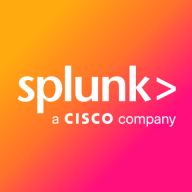

Splunk Observability Cloud and Sumo Logic Observability are products competing in the performance monitoring and analytics category. Splunk has the edge in features due to its robust capabilities, while Sumo Logic leads in ease of deployment and customer service owing to its streamlined setup and support.
Features: Splunk Observability Cloud offers real-time streaming analytics, comprehensive metric collection, and flexible visual dashboards. Sumo Logic Observability emphasizes log management, advanced machine learning-driven analytics, and offers customizable dashboards.
Room for Improvement: Splunk could enhance its deployment complexity to be more user-friendly and reduce setup time. It also needs to improve on user interface customizations and streamline customer support communication. Sumo Logic could work on expanding its feature set to match Splunk's variety and depth, improve its data integration capabilities, and enhance its advanced analytics functions for more complex data analyses.
Ease of Deployment and Customer Service: Sumo Logic Observability wins in this category with straightforward deployment and responsive customer support, thanks to its scalable cloud native infrastructure. Splunk Observability Cloud offers a robust setup but requires more time and expertise for initial configuration, adding complexity to deployment.
Pricing and ROI: Splunk Observability Cloud involves higher initial setup costs but promises strong ROI due to its extensive features. Sumo Logic Observability provides more cost-effective options, appealing to smaller enterprises seeking quick returns. The investment in Splunk is worthwhile for its comprehensive analytics despite Sumo Logic's attractive pricing.
Using Splunk has saved my organization about 30% of our budget compared to using multiple different monitoring products.
Anyone working in front-end management should recognize the market price to see the true value of end-user monitoring.
I have definitely seen a return on investment with Splunk Observability Cloud, particularly through how fast it has grown and how comfortable other teams are in relying on its outputs for monitoring and observability.
On a scale of 1 to 10, the customer service and technical support deserve a 10.
They have consistently helped us resolve any issues we've encountered.
They often require multiple questions, with five or six emails to get a response.
We've used the solution across more than 250 people, including engineers.
As we are a growing company transitioning all our applications to the cloud, and with the increasing number of cloud-native applications, Splunk Observability Cloud will help us achieve digital resiliency and reduce our mean time to resolution.
I would rate its scalability a nine out of ten.
I would rate its stability a nine out of ten.
We rarely have problems accessing the dashboard or the page.
Unlike NetScout or regular agents for APM, RUM has many problems during the POC phase because customer environments vary widely.
The out-of-the-box customizable dashboards in Splunk Observability Cloud are very effective in showcasing IT performance to business leaders.
The next release of Splunk Observability Cloud should include a feature that makes it so that when looking at charts and dashboards, and also looking at one environment regardless of the product feature that you're in, APM, infrastructure, RUM, the environment that is chosen in the first location when you sign into Splunk Observability Cloud needs to stay persistent all the way through.
There is room for improvement in the alerting system, which is complicated and has less documentation available.
Splunk is a bit expensive since it charges based on the indexing rate of data.
It is expensive, especially when there are other vendors that offer something similar for much cheaper.
It appears to be expensive compared to competitors.
Splunk provides advanced notifications of roadblocks in the application, which helps us to improve and avoid impacts during high-volume days.
For troubleshooting, we can detect problems in seconds, which is particularly helpful for digital teams.
It offers unified visibility for logs, metrics, and traces.
| Product | Market Share (%) |
|---|---|
| Splunk Observability Cloud | 2.2% |
| Sumo Logic Observability | 0.5% |
| Other | 97.3% |


| Company Size | Count |
|---|---|
| Small Business | 20 |
| Midsize Enterprise | 10 |
| Large Enterprise | 47 |
Splunk Observability Cloud offers sophisticated log searching, data integration, and customizable dashboards. With rapid deployment and ease of use, this cloud service enhances monitoring capabilities across IT infrastructures for comprehensive end-to-end visibility.
Focused on enhancing performance management and security, Splunk Observability Cloud supports environments through its data visualization and analysis tools. Users appreciate its robust application performance monitoring and troubleshooting insights. However, improvements in integrations, interface customization, scalability, and automation are needed. Users find value in its capabilities for infrastructure and network monitoring, as well as log analytics, albeit cost considerations and better documentation are desired. Enhancements in real-time monitoring and network protection are also noted as areas for development.
What are the key features?In industries, Splunk Observability Cloud is implemented for security management by analyzing logs from detection systems, offering real-time alerts and troubleshooting for cloud-native applications. It is leveraged for machine data analysis, improving infrastructure visibility and supporting network and application performance management efforts.
Sumo Logic Observability offers advanced monitoring solutions with features like integrated dashboards and querying capabilities, though presents a learning curve compared to alternatives. Designed for efficient log aggregation and analysis, it provides near-real-time updates facilitating improved incident resolution.
Sumo Logic Observability stands out with its ability to unify teams through a single platform, offering features that include customizable dashboards and valuable apps. It provides powerful log tracing and centralized management, designed for organizations focused on log aggregation, analysis, and expanding SIEM capabilities. While it has a steeper learning curve compared to some competitors, it excels in tailored integrations that enhance log searches. Users find themselves able to monitor, automate, and centralize log repositories for effective debugging. Despite its strengths, improvements in data enrichment and documentation organization are needed as current query functions can be slow, impacting efficiency. Users have also mentioned needing pre-built dashboards and better tab management for enhanced functionality. Cost management remains a notable consideration for users evaluating Sumo Logic Observability.
What features make Sumo Logic Observability effective?Sumo Logic Observability is implemented across industries predominantly for managing and analyzing extensive data sets, offering capabilities critical for SIEM activities and security examinations. By facilitating quick data visualization and transaction tracking, organizations in sectors such as finance, healthcare, and technology benefit from its robust framework to support infrastructure logging and large-scale data management, contributing to effective monitoring and system operations.
We monitor all Application Performance Monitoring (APM) and Observability reviews to prevent fraudulent reviews and keep review quality high. We do not post reviews by company employees or direct competitors. We validate each review for authenticity via cross-reference with LinkedIn, and personal follow-up with the reviewer when necessary.